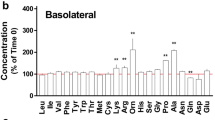Abstract
We have investigated the possible relation between the phloridzin-sensitive influx of α-methyl-D-glucoside (concentration 5 mmol/l) and the brush border surface area, in chicken isolated enterocytes. The intestinal regions studied were: jejunum and proximal cecum (both with high affinity sugar transport sites), medial cecum (with a low affinity transport system) and distal cecum (which lacks any transport ability). Cell apical surface measured by electron microscopy gave the following results; jejunal cells (0.41 μm2) >proximal cecal cells (0.23 μm2)>medial cecal cells (0.15 μm2)=distal cecal cells (0.14 μm2). This parameter is mainly determined by the length of microvilli. Sugar influx studies showed that the concentration of the substrate in cell water (in mmol/l) was jejunum (7.1)>proximal cecum (2.9) >medial cecum (1.7)>distal cecum (not different from zero). The decline in influx rate from proximal to distal cecum may be explained both by changes in surface and by the different carriers involved (differentK m). Results of sugar concentration in the distal cecal cells do not correlate with the other segments studied since the substrate enters in these cells by a passive process. It is concluded that the degree of development of microvilli should be taken into account when estimating nutrient transport rates in different intestinal segments.
Similar content being viewed by others
References
Annison EF, Hill KJ, Kenworthy R (1968) Volatile fatty acids in the digestive tract of the fowl. Br J Nutr 22:207–216
Calhoun ML (1933) The microscopic anatomy of the digestive tract ofGallus domesticus. Iowa State College J Sci 7:261–381
Coates MF, Gregory ME, Porter JWG, Williams AP (1963) Vitamin B and its analogues in the gut contents of germ-free and conventional chicks. Proc Nutr Soc 22:27–35
Ferrer R (1985) Estudi histològic i del transport de monosacàrids dels segments cecals del pollastre. Doctoral Thesis. Facultat de Farmàcia. Universitat de Barcelona
Ferrer R, Planas JM, Moretó M (1986a) Age-related changes in α-methyl-D-glucoside accumulation by cecal and jejunal chicken enterocytes. IRCS Med Sci 14:78–79
Ferrer R, Planas JM, Moretó M (1986b) Characteristics of the chicken proximal cecum hexose transport system. Pflügers Arch 407:100–104
Ferrer R, Planas JM, Moretó M (1986c) Preparation and properties of isolated epithelial intestinal cells from chicken cecum and jejunum. Rev esp Fisiol 42:341–348
Ferrer R, Planas JM, Moretó M (1986d) Morphological study of chicken cecal and jejunal mucosa during epithelial cell isolation. Rev esp Fisiol 42:349–354
Kimmich GA (1970) Active sugar accumulation by isolated intestinal epithelial cells: a new model for sodium-dependent metabolite transport. Biochemistry 9:3669–3677
Kimmich GA, Randles J (1981) α-Methylglucoside satisfies only Na+-dependent transport system of intestinal epithelium. Am J Physiol 241:C227-C232
Nesheim MC, Carpenter KJ (1967) The digestion of heat damaged protein. Br J Nutr 21:399–411
Planas JM, Villá MC, Ferrer R, Moretó M (1986) Hexose transport by chicken cecum during development. Pflügers Arch 407:216–220
Reynolds ES (1963) The use of lead citrate at high pH as an electron opaque stain in electron microscopy. J Cell Bioll 17:208–212
Rice GE, Skadhauge E (1982) Caecal water and electrolyte absorption and the effects of acetate and glucose, in dehydrated, lowNaCl diet hens. J Comp Physiol 147:61–64
Röseler M (1929) Die Bedeutung der Blinddärme des Haushuhnes für die Resorption der Nahrung und die Verdauung der Rohfaser. Z Tierzucht Züchtungsbiol 13:281–310
Vinardell MP, Lopera MT, Moretó M (1986) Absorption of 3-oxy-methyl-D-glucoside by chicken cecum and jejunum in vivo. Comp Biochem Physiol 85A:171–173
Author information
Authors and Affiliations
Rights and permissions
About this article
Cite this article
Planas, J.M., Ferrer, R. & Moretó, M. Relation between α-methyl-D-glucoside influx and brush border surface area in enterocytes from chicken cecum and jejunum. Pflugers Arch. 408, 515–518 (1987). https://doi.org/10.1007/BF00585078
Received:
Accepted:
Issue Date:
DOI: https://doi.org/10.1007/BF00585078




